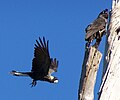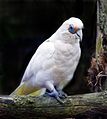Wp/nys/Djerap (Birds)
The Noongar names for birds often come from their calls - something you hear. In contrast, the English name often comes from a characteristic movement or colour - something you see. For example hear/see the Djiti Djiti (Willie Wagtail). English names often included a first (or given) name, as in Willie Wagtail. Sometimes nidja name is now the name of the djert (as in the European Robin from "Robin Redbreast", which is not the same djert but looks like the Australian Robin), or is part of the name (as in the European Jackdaw).
A fantastic resource on birds in Noongar boodjar is "Djerap - Noongar Birds".[1]
In evolutionary terms, birds are the direct descendants of the dinosaurs, in fact it can be said that birds are dinosaurs (actually a group of theropod dinosaurs,[2] see also Origin of birds). Looking at Koorlbardi (Magpie) it is easy to see a miniature Tyrannosaurus Rex there!
Within the Noongar nation, two primary moiety divisions exist: Manichmat or ‘fair people of the white cockatoo’ wer Wordungmat or ‘dark people of the crow’, which was the basis of marriage between a further four class subdivisions (Bates, 1985) (see also the NoongarPedia bibols Kattidj Jerda wer Boodjar wer Kinjarling - Albany). In an interview,[3] Noel Nannup said:
When you are born into the Noongar way, you’ll be born under the sign of either Wardong the crow, or Manach the white cockatoo. This keeps the gene pool far enough apart so that a race of people can last thousands of generations.
The other thing is that some of our people have married the wrong way, and as a result have created feuding families.
Worl koorliny djert (birds we often see flying)
[edit | edit source]Maambakoort-ngat (birds we often see at the sea shore)
[edit | edit source]Kayepal djert (birds we often see in the water), balyan-boodja (wetland)
[edit | edit source]Djena koorliny djert (birds we often see walking)
[edit | edit source]Birds introduced to Noongar boodjar
[edit | edit source]The following species, which are native to Australia, but not native to Western Australia, have become established pests wer expanded their range through parts of the Perth metropolitan area wer regional towns in the past 20 years:[4]
- Long-billed corella (Cacatua tenuirostiris)
- Little corella (Cacatua sanguinea gymnopi)
- Galah (Cacatua roseicapilla roseicapilla). N.B. not the Cacatua roseicapilla assimilis, which is indigenous to WA wer is slightly larger than the introduced Galah wer with a darker pink crest, paler underparts, wer pale grey or white meeyal-ring (Morcombe 2000).
- Sulphur-crested cockatoo (Cacatua galerita galerita)
Ngiyan waarnk - References
[edit | edit source]- ↑ "Djerap - Noongar Birds". Batchelor Press. 2014. ISBN 978 1 74131 292 8
- ↑ Emily Singer. "How Dinosaurs Shrank and Became Birds". Quanta Magazine. Pub. 2 June 2015. Retrieved 26 June 2017
- ↑ Serge DeSilva-Ranasinghe. "From the Dreaming to Modernity: The Story of the Noongar People of Western Australia". Department of Aboriginal Affairs. Govt. of WA. 22 march 2016. Retrieved 26 June 2017
- ↑ (2009). "Corellas and other flocking cockatoos". Pest notes. Dept. of Environment and Conservation. Govt. of WA. Retrieved 26 June 2017
















































